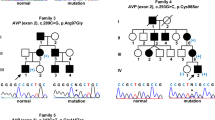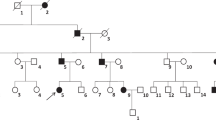Abstract
The autosomal dominant familial neurohypophyseal diabetes insipidus (adFNDI) is caused by diverse mutations in one allele of the gene that encodes the arginine vasopressin (AVP) precursor protein, AVP-neurophysin II (AVP-NP II). Most of the mutations identified so far are located in either the signal peptide or NP II moiety. Two recently published mutations in the AVP gene identified in kindreds with adFNDI predict a substitution of histidine for tyrosine at position 2 and a deletion of phenylalanine at position 3 in AVP. They are unique among adFNDI mutations in that they are the only adFNDI mutations that affect amino acid residues in the AVP moiety of the pro-hormone. Here, we report a novel heterozygous missense mutation in the AVP moiety of the AVP-NP II gene in a Japanese person with neurohypophyseal DI (diabetes insipidus). This mutation occurs at position 2 in AVP and predicts a substitution of serine for tyrosine (Y21S). It is expected to interfere with normal binding of AVP with NP II, and thus result in misfolding of the precursor proteins. The data of this study support the notion that mutations affecting the AVP moiety can result in the initiation of the pathological processes. (J. Endocrinol. Invest. 29: 252–256, 2006)
Similar content being viewed by others
References
Hansen L, Rittig S, Robertson GL. Genetic basis of familial neurohypophyseal diabetes insipidus. Trends Endocrinol Metab1997, 8: 363–72.
Braberman LE, Mancini JP, McGoldrick DM. Hereditary diabetes insipidus: a case report with autopsy findings. Ann Intern Med 1965, 63: 503–8.
Green J, Buchan G, Alvord JE, wanson A. Hereditary and idiopathic types of diabetes insipidus. Brain 1967, 90: 707–14.
Browstein MJ, Russel JT, Gainer H. Synthesis, transport, and release of posterior pituitary hormones. Science 1980, 207: 373–8.
Rittig S, Siggaard C, Ozata M, et al. Autosomal dominant neurohypophyseal diabetes insipidus due to substitution of histidine for tyrosine2 in the vasopressin moiety of the hormone precursor. J Clin Endocrinol Metab 2002, 87: 3351–5.
Wahlstrom JT, Fowler MJ, Nicholson WE, Kovacs WJ. A novel mutation in the preprovasopressin gene identified in a kindred with autosomal dominant neurohypophyseal diabetes insipidus. J Clin Endocrinol Metab 2004, 89: 1963–8.
Rittig S, Robertson GL, Siggaard C, et al. Identification of 13 new mutations in the vasopressin-neurophysin II gene in 17 kindreds with familial autosomal dominant neurohypophyseal diabetes insipidus. Am J Hum Genet 1996, 58: 107–17.
Ito M, Jameson JL, Ito M. Molecular basis of autosomal dominant neurohypophyseal diabetes insipidus. Cellular toxicity caused by the accumulation of mutant vasopressin precursors within the endoplasmic reticulum. J Clin Invest 1997, 99: 1897–905.
Imura H, Nakao K, Shimatsu A, et al. Lymphocytic infundibuloneurohypophysitis as a cause of central diabetes insipidus. N Engl J Med 1993, 329: 683–9.
Wass JAH, Besser M. Tests of pituitaryfunction. In: DeGroot LJ eds. Endocrinology. 3rd ed. Philadelphia: W.B. Saunders. 1995, 487–96.
Kobayashi H, Ogawa Y, Shintani M, et al. A novel homozygous missense mutation of melanocortin-4 receptor (MC4R)in a Japanese woman with severe obesity. Diabetes 2002, 51: 243–6.
Miyakoshi M, Kamoi K, Murase T, Sugimura Y, Oiso Y. Novel mutant vasopressin-neurophysin II gene associated with familial neurohypophyseal diabetes insipidus. Endocr J 2004, 51: 551–6.
Willcutts MD, Felner E, White PC. Autosomal recessive familial neurohypophyseal diabetes insipidus with continued secretion of mutant weakly active vasopressin. Hum Mol Genet 1999, 8: 1303–7.
Christensen JH, Siggaard C, Corydon TJ, et al. Impaired trafficking of mutated AVP prohormone in cells expressing rare disease genes causing autosomal dominant familial neurohypophyseal diabetes insipidus. Clin Endocrinol (Oxf) 2004, 60: 125–36.
De Bree FM, van der Kleij AAM, Burbach JPH. Functional role of hormone-neurophysin association in hormone biosynthesis. In: Neurohypophysitis: recent progress of vasopressin and oxtocin research. Tokyo: Elsevier Science BV. 1995, 143–8.
Nicholas P, Batelier G, Rholam M, Cohen P. Bovine neurophysin dimerization and neurohypophyseal hormone binding. Biochemistry 1980, 19: 3565–73.
Kanmera T, Chaiken IM. Molecular properties of the oxytocin/bovine neurophysin biosynthesis prescursor. Studies using a semisynthetic precursor. J Biol Chem 1985, 260: 8474–82.
Chen LQ, Rose JP, Breslow E, et al. Crystal structure of a bovine neurophysin II dipeptide complex at 2.8 A determined from the singlewavelength anomalous scattering signal of an incorporated iodine atom. Proc Natl Acad Sci U S A 1991, 88: 4240–4.
Breslow E, Mombouyran V, Deeb R, et al. Structural basis of neurophysin hormone specificity: geometry, polarity, and polarizability in aromatic ring interactions. Protein Sci 1999, 8: 820–31.
Russel TA, Ito M, Ito M, et al. A murine model of autosomal dominant neurohypophyseal diabetes insipidus reveals progressive loss of vasopressin-producing neurons. J Clin Invest 2003, 112: 1697–706.
Author information
Authors and Affiliations
Corresponding author
Rights and permissions
About this article
Cite this article
Kobayashi, H., Fujisawa, I., Ikeda, K. et al. A novel heterozygous missense mutation in the vasopressin moiety is identified in a Japanese person with neurohypophyseal diabetes insipidus. J Endocrinol Invest 29, 252–256 (2006). https://doi.org/10.1007/BF03345549
Accepted:
Published:
Issue Date:
DOI: https://doi.org/10.1007/BF03345549




